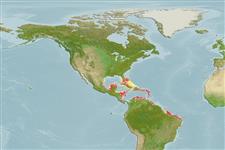Common names from other countries
Environment: milieu / climate zone / depth range / distribution range
экология
; солоноватоводный; пределы глубины 2 - 15 m (Ref. 415). Tropical
Western Central Atlantic.
Length at first maturity / Size / Вес / Возраст
Maturity: Lm ? range ? - ? cm Max length : 0.2 cm OT самец/пол неопределен; (Ref. 415)
Encrusting sponge, 0.1 - 0.2 cm thickness. Smooth, and slippery surface, with regularly dispersed oscula: 0.2 - 0.3 cm in diameter. A conspicuous star-shaped canal system surrounds each oscula (Ref. 415). Color: light to dark blue or violet. Leathery (Ref. 85482).
Maximum body thickness: 0.2 cm (Ref. 415). On dead coral in reef environments: 2 to 15 m deep (Ref. 415). Also found in mangroves (Ref. 86836). Favors coral undersides, overhangs, and crevices in shallow and deep reefs and hard bottoms (Ref. 85482).
Life cycle and mating behavior
половая зрелость | размножение | нерест | икра | Fecundity | личинки
Members of the class Demospongiae are hermaphroditic. Life cycle: The zygote develops into parenchymella larva (free-swimming) before settling down on a substrate where it grows into a young sponge.
Основная ссылка
ссылки | координатор | соавторы
Collin, R., M.C. Díaz, J. Norenburg, R.M. Rocha, J.A. Sánchez, M. Schulze, A. Schwartz and A. Valdés. 2005. (Ref. 415)
Статус Красного Списка МСОП (Ref. 130435)
Статус СИТЕС (Ref. 108899)
Not Evaluated
Not Evaluated
Угроза для людей
Harmless
Использование человеком
| FishSource |
инструменты
дополнительная информация
ресурсы в Интернет
Estimates based on models
Preferred temperature
(Ref.
115969): 26.4 - 28.2, mean 27.5 (based on 517 cells).
Уязвимость
Low vulnerability (10 of 100).
Категория цены
Unknown.
